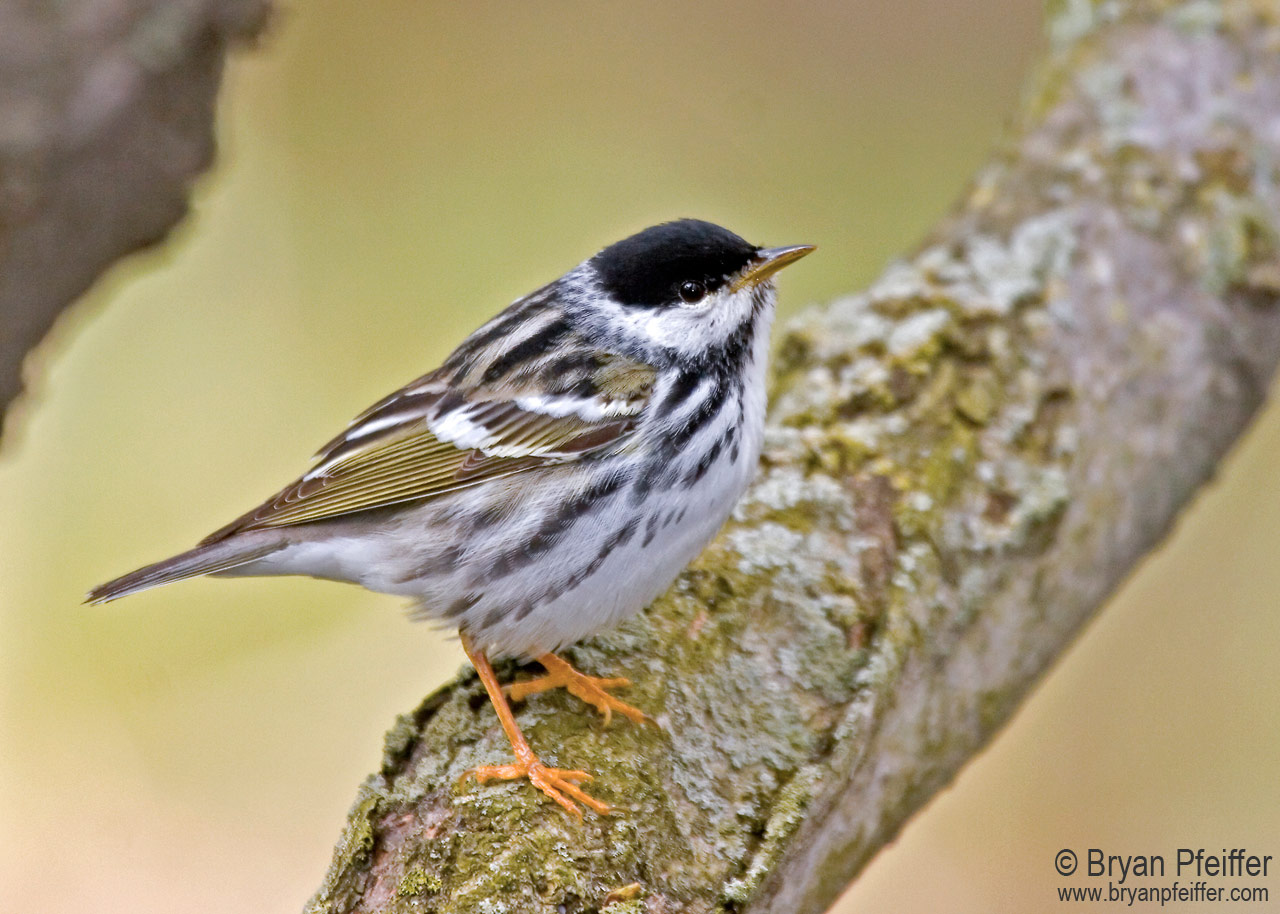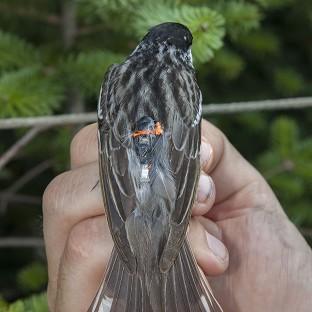A Blackpoll Warbler’s Daring Trans-Atlantic Flight
 Two wings and a prayer carry a Blackpoll Warbler on a remarkable journey to South America each autumn. Well, actually, two wings and the audacity to pull off one of the most amazing feats of migration on the planet: a non-stop, trans-Atlantic flight lasting up to three days.
Two wings and a prayer carry a Blackpoll Warbler on a remarkable journey to South America each autumn. Well, actually, two wings and the audacity to pull off one of the most amazing feats of migration on the planet: a non-stop, trans-Atlantic flight lasting up to three days.
With most of us only speculating for decades about this amazing journey, my colleagues at the Vermont Center for Ecostudies (VCE) today announced proof. Blackpoll Warblers fitted with miniature tracking devices took off from points in either Nova Scotia or the northeastern U.S. and flew south over the Atlantic, with no safe place to land, until reaching Caribbean islands roughly 1,600 miles away.
“This is one of the most ambitious migrations of any bird on earth,” said VCE’s Executive Director, Chris Rimmer, co-author of a research paper published today on the warbler flights. “We’ve also documented one of the longest nonstop, overwater flights ever recorded for a songbird.”
This wisp of a bird, weighing half an ounce, with a high, thin pulsing song, breeds in boreal woods from Alaska, across Canada, and into high forests of the Northeast. But migration puts the blackpoll in another league. Tthe vast majority of migratory songbirds that winter in South America take a less risky, continental route south through Mexico and Central America. The blackpoll is a mariner. From its boreal breeding grounds, blackpolls move southeast toward the coasts of maritime Canada, New England, and shoreline points south. Then, when crisp autumn winds blow from behind, the blackpoll – in what is less a leap of faith than an airborne example of evolution – launches out to sea for two or three days of non-stop flapping.
At least that had been the prevailing hypothesis. Until now, we had only circumstantial evidence to support this iconoclastic route: lots of blackpolls at coastal sites in the fall, blackpolls spotted from ships at sea, and relatively few blackpolls in southeastern states and Central America (where we would expect to find them on a more terrestrial southbound route). Although other birds — albatrosses, sandpipers and gulls, for example — are known for trans-oceanic flights, the Blackpoll Warbler, as a forest dweller, is an iconoclast migrating boldly where few of its relatives dare travel. A water landing would be fatal to a warbler.
To track the flights, VCE and its colleagues in 2013 captured warblers here in Vermont and in Nova Scotia and fitted them with miniature devices called “light-level geolocators,” which resemble songbird backpacks. The warblers migrated south in the fall, spent a winter in the tropics, then returned in spring to North American breeding sites, where VCE biologists recaptured five birds, removed their geolocators, which for the year kepts track of the warblers’ whereabouts. VCE then downloaded the flight itineraries.
Four warblers, including two from Vermont, had departed between Sept 25 and Oct 21 from points somewhere between western Nova Scotia and western Long Island or New Jersey, and flew day and night over the Atlantic Ocean until landing in either Hispaniola or Puerto Rico. Their flight times ranged from 49 to 73 hours.
After reaching the islands of Hispaniola and Puerto Rico, the study’s warblers rested, fed and took off again, this time to cross the Caribbean Sea toward wintering destinations in either northern Colombia or Venezuela.
A fifth bird, which VCE had also first captured in Vermont, likely took a shorter trans-oceanic trip. It departed the mainland on November 4 from Cape Hatteras and then flew nearly 1,000 miles non-stop for 18 hours later to land in Turks and Caicos before continuing on to South America.
On the return trip north, the Blackpoll Warblers took a more westerly route, flying to Cuba or Florida, then moving north along the eastern U.S. seaboard before arriving back on the breeding grounds in Vermont and Nova Scotia in late May.
Unlike GPS devices, which are too large and heavy for the warblers, geolocators use miniaturized sensors to detect and record solar light-level data hundreds of times each day. These data are stored on a tiny computer chip and can be downloaded only if the birds are recaptured. Daily locations can then be inferred from calculations based on day length and the timing of solar noon and midnight.
Why the warblers choose the ocean route isn’t exactly clear. Normally taking weeks or months to complete, migration can be the most perilous part of a songbird’s life. We suspect that Blackpoll Warblers balance the risks of a trans-oceanic flight with the benefits of a speedy and determined migration.
Fat and Flight
 The sea and its trade winds welcome the Arctic Tern and American Golden Plover, celebrated transoceanic migrants. But a warbler? How can a woodland bird make a similar journey?
The sea and its trade winds welcome the Arctic Tern and American Golden Plover, celebrated transoceanic migrants. But a warbler? How can a woodland bird make a similar journey?
It does so with the same currency as the tern and the plover: fat. The blackpoll gains weight – a lot of weight – before its flight. After breeding in July, the average Blackpoll Warbler weighs in at about 10 to 12 grams (no more than half an ounce), which means you could mail two blackpolls anywhere in the U.S. for the price of a first-class stamp. But before the fall flight, blackpolls nearly double their mass as they binge on insects, spiders, seeds, and fruit. They store the feast as fat and then burn it efficiently at sea.
Generally, the greater a bird’s fat reserves (as a percentage of its body weight) the farther it can fly without stopping to refuel (eat). After all, risks await birds during those rest stops, including uncertain habitat and predation by hawks, house cats, and other animals.
Yet, the benefits of fat reserves and nonstop flight carry their own risks. A bird focusing on food before migration may be less alert and an easier mark for predators. A fatter bird may lack the acceleration and agility necessary to avoid hawks and falcons in flight. And for a warbler over the ocean, there is no rest stop, no port in a storm, no rescue from a water landing.
On balance, the Blackpoll Warbler, more fat than feather, takes a course evolution has charted at sea. Making the flight from, say, Maine to Brazil, a blackpoll burns less fat than we find in a single serving of Ben & Jerry’s Coffee Heath Bar Crunch.
If only the rest of us had such an effective use for ice cream.
The paper in Biology Letters is: Transoceanic migration by a 12 g songbird. William V. DeLuca, Bradley K. Woodworth, Christopher C. Rimmer, Peter P. Marra, Philip D. Taylor, Kent P. McFarland, Stuart A. Mackenzie, D. Ryan Norris. Biol. Lett.: 2015 11 20141045; DOI: 10.1098/rsbl.2014.1045. Published 1 April 2015.


Thank you for mentioning house cats (more accurately “free roaming” cats) as a risk to these and other birds. More awareness needs to be made of the estimated 3 to 4 billion birds killed each year by free roaming cats in the continental US. Not to mention the other small mammals.
Why do they do it? Why why why? What’s the evolutionary benefit of taking such a hard route? But for context…I am just back from dinner at the Wayside Diner, where I parked, and then actually turned on the engine to park about 15 feet closer to the diner when a spot opened….
What an incredible story. I can’t even imagine how such a flight is possible!